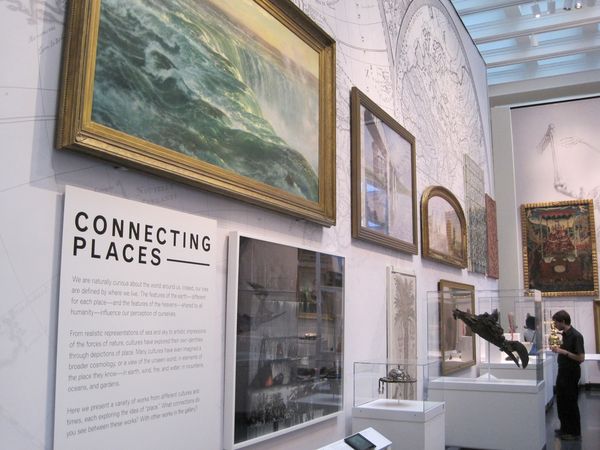Exhibiting Architecture in a Salon
Yesterday conservator Kerith Koss introduced readers to a late 16th- or early 17th-century Ottoman tile panel (39.407.1-.54), is currently on view in Connecting Cultures: A World in Brooklyn, and today I’ll discuss the panel from a curatorial perspective.
The tiles in the panel were likely made in Damascus, Syria, an important provincial capital after its conquest by the Ottomans in 1516. Damascene ceramics workshops were influenced by a style of vegetal decoration associated with Iznik, Turkey, a center for ceramic production in the Ottoman Empire, but they adapted color schemes to include cobalt-blue, turquoise, green, and purple. (For an example of Iznik decoration, see this ornament in our Arts of the Islamic World gallery.) Motifs and brushwork on ceramics from Damascus at this time are generally more relaxed than on Iznik examples, where imagery was court-controlled.
We do not know in which building the tiles now at the Brooklyn Museum initially hung. Many buildings from the same period, such as the Darwish Pasha Mosque built by the Ottoman governor, and other museum collections (i.e., The Met and the V&A) include examples of similar tile work.

Darwish Pasha Mosque, Damascus, Syria, 1574, detail of portico showing two tile panels to the west of the entrance (©Michael Greenhalgh, image via Archnet.org)
As Kerith mentioned, the tiles were assembled into a panel upon arrival to the Museum in 1939. Such reconstructions were commonplace during the early 20th century. Numbers on the tiles and breaks in the decorative scheme suggest a larger original. (Can you spot breaks? It took me awhile at first.) Perhaps damaged tiles were removed and existing ones rearranged, or perhaps the panel includes tiles from various sources. We only know that the tiles came from multiple firing batches due to differences in glazing.
You might assume that all museum objects look now as they did upon creation, but this is often untrue following subsequent interventions. This composite panel is a piece of architecture from Syria that now—approximately 400 years later—functions as a standalone art object on another continent. The reuse of architectural elements has been common throughout Islamic architecture, but they undergo further changes when removed from buildings altogether. Pieces entered European and American collections and museums in the twentieth century, and adjustments occurred for various reasons by those possibly unfamiliar with their original use.
In Connecting Cultures, works are hung in a collage-like formation or “salon hanging.” You get a sense of the panel as an art object conversing with surrounding objects. It appears six feet above the floor on the wall devoted to the theme “Connecting Place”—a completely different placement and environment than in the Darwish Pasha Mosque. In Brooklyn the panel is surrounded by a 17th-century sandstone panel from Mughal India, aTunisian Roman–periodmosaic, and paintings depicting places as diverse as Niagara Falls, Cairo, and Europe.
While these tiles now hang differently than originally intended in a museum far from Damascus, I hope that their inclusion in Connecting Cultures, particularly in relation to the theme of “place,” encourages you to consider the interesting conversation provoked by their proximity to other representations of “place” as well as the significant effects of places—Ottoman Syria, private collection(s), and the Brooklyn Museum—and human agents upon these tiles.

Caitlin McKenna Thakral joined the Brooklyn Museum in 2011, and is now Research Associate of Islamic Art. She studied art history at Colgate University (BA) and the Institute of Fine Art Arts, New York University (MA). Before coming to Brooklyn, she was involved with museum projects and exhibitions at various institutions, including the Grey Art Gallery at NYU and the Guggenheim Museum. Her academic research on medieval Islamic architecture has been supported through travel abroad sponsored jointly by the Kunsthistorisches Institut in Florenz, Max-Planck-Institut, and the Getty Foundation. Her interests include working with content in all forms, taking field trips to grocery stores in foreign cities, and attempting Bollywood dance.


